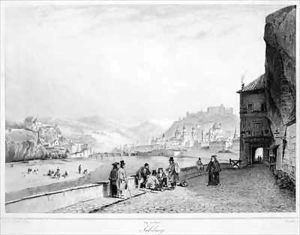Karl Johann Billmark Paintings
Karl Johann Billmark was a Swedish landscape painter, engraver, and lithographer, born in 1804 in Stockholm, Sweden. His work is characterized by its detailed and evocative depictions of landscapes, often capturing the scenic beauty of the Swedish countryside as well as other European locations. Billmark's talent for landscape painting was evident from an early age, and he devoted his life to exploring and refining this craft.
Billmark received his artistic training at the Royal Swedish Academy of Arts in Stockholm, where he honed his skills in drawing, painting, and printmaking. His early works were primarily engravings and lithographs, a medium through which he gained considerable recognition. He was particularly adept at lithography, a printmaking technique that was relatively new at the time, and he contributed significantly to its popularity and development in Sweden.
In the 1830s, Billmark began to travel extensively throughout Europe, a practice that greatly influenced his artistic output. He visited France, Italy, and Switzerland, among other countries, drawing inspiration from the diverse landscapes and historical sites he encountered. These travels were pivotal in shaping his approach to landscape painting, as they exposed him to a wide range of natural and architectural motifs.
Throughout his career, Billmark exhibited his works in various prestigious venues, including the Paris Salon, one of the most important art exhibitions of the 19th century. His landscapes were well-received by both critics and the public, and he earned numerous awards and accolades for his contributions to Swedish art. Billmark's works were characterized by their meticulous attention to detail, vibrant color palette, and the ability to evoke a sense of place and atmosphere.
Karl Johann Billmark passed away in 1870, leaving behind a legacy as one of Sweden's most celebrated landscape artists. His paintings and prints continue to be admired for their beauty and technical skill, and his influence can be seen in the work of subsequent generations of Swedish artists. Billmark's dedication to capturing the natural and architectural wonders of the world has cemented his place in the annals of 19th-century European art.
